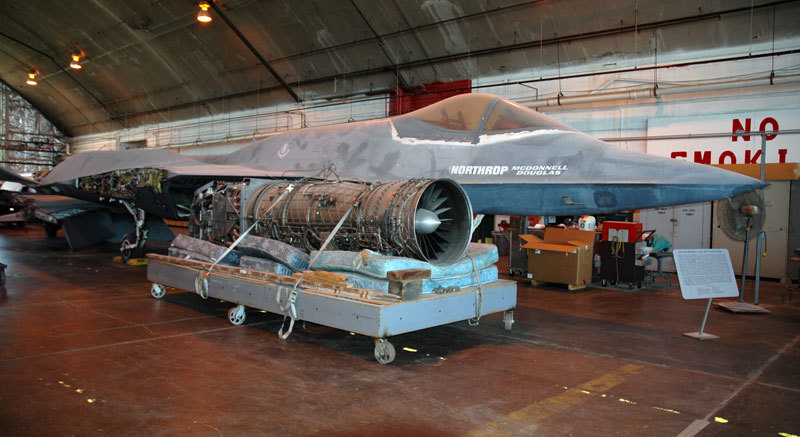|
Godholio posted:It wasn't that great, really. It's got a cult following because of the lightweight fighter community, but it was competition against the superior F-16. The F-20 was the culmination of the F-5 platform...it was maxed out on what they could do. They couldn't give it a better engine, radar, or payload. On the other hand, there was the F-16...in performance very similar, but with much more available internal space (this is good for upgrades), a better radar (the APG-67 was mediocre in air-to-air modes, even for the time). Dwindling sales opportunities (after the F-16 was sold to Pakistan I think, and China was making a big deal out of potential sales to Taiwan), and Congressional lobbying for long-term F-16 production in Texas were just the final nails. Oh, I agree. I guess by "great" I meant "probably the best lightweight-fighter option at the time when you take unit cost into consideration."  I can't see that the F-20 would have ever been even closet to as good a bomb truck as the F-16 is now, either. I can't see that the F-20 would have ever been even closet to as good a bomb truck as the F-16 is now, either.It did look drat cool, though.
|
|
|
|

|
| # ? Apr 25, 2024 20:47 |
|
Minto Took posted:The only fighter metric that matters. That can't be true, because if it was, everyone'd be bitching about all the problems and cost overruns on the F-23.
|
|
|
|
   You were the one that should have been. 
|
|
|
|
Godaaaamn that is one sexy beast.
|
|
|
|
Minto Took posted:
 yf-23-3 by RReiheld, on Flickr  YF-23 by RReiheld, on Flickr
|
|
|
|
That's awful. Where's it stored?
|
|
|
|
Are mattresses a standard way of storing engines?
|
|
|
|
If it's being stored under the AF budget, yeah.
|
|
|
|
Why would they cut off its wings?  The YF-23 really was the one that should have been. It makes the F-22 look downright bloated and completely out-of-date. Why did the -22 win, again? I had heard that the -23 was stealthier and faster, but the -22 could turn tighter thanks to the thrust-vectoring, and we all know that the Russkies have been able to pull off those dumb airshow backwards-firing missile moves for years so damned if we can allow there to be a dumb airshow backwards-firing missile gap, says the USAF. Is that actually the case?
|
|
|
|
Sagebrush posted:Why did the -22 win, again? I had heard that the -23 was stealthier and faster, but the -22 could turn tighter thanks to the thrust-vectoring, and we all know that the Russkies have been able to pull off those dumb airshow backwards-firing missile moves for years so damned if we can allow there to be a dumb airshow backwards-firing missile gap, says the USAF. Is that actually the case? To make a long story short, the Air Force bought into Lockheed's bullshit salesmanship. Sure, they claimed the YF-22 was closer to the production aircraft than the YF-23 was (which was sort of true), would be cheaper to operate (which sort of wasn't true) and they fired a missile in the evaluation (which was not required, and interestingly enough almost caused the loss of the aircraft). At the end of the day, both aircraft were evaluated against what the production aircraft was going to be; it was felt at the time that the F-22 was the least risky of the two. Looking back, you'd have a hard time convincing anyone of that now.
|
|
|
|
Sagebrush posted:Why would they cut off its wings? Part of the Air Force requirements for the F-22/F-23 were rather ridiculous, between the 'missile gap' and 'maneuverability' issues, it was forced through too quickly for the perceived 5th generation fighter deadline.
|
|
|
|
Godholio posted:That's awful. Where's it stored? That is about 10 years back at the USAF museum restoration hangar. They've got it put back together now with a fresh coat of paint, I'm heading through on the way home for christmas, will grab a few pictures of it crowded up under the XB-70. The thing about the F-23 is that it was bigger than the F-22, and that generally means it is going to cost more. Also Northrop had a miserable record for cost control and on-time delivery, and Lockheed had, until the F-22, actually a pretty good one. Remember that Northrop was coming off the B-2 program, and Lockheed was coming off the F-117 program, so they had those odors respectively.
|
|
|
|
Sagebrush posted:Why would they cut off its wings? Transportation. Wings are relatively removable.
|
|
|
|
I've always wondered what happens to the cancelled programs like the F-23. Building the prototype for a loser-goes-home contest seems like a waste of money. Couldn't they shop it around to Canada, England, Germany, Turkey, etc? Or is it just that the US is the only country in the world with the budget to afford it?
|
|
|
|
Jobs program. Having the defence industry spooled up ready to go is a major benefit if you end up in a land war with Russia or China... or India or Brazil. You can't train 20,000 aerospace engineers with twenty years of defence experience in three months like you can infantry, and if they run out of work here they can easily go to France, Germany or anywhere in the world really for the same pay. Having a continuous stream of projects here helps keep them from looking abroad. When you need to downsize your infantry on the other hand, the infantry just goes back to being domestic gas station attendants and grocery store cashiers. I mean, do you really think NASA is going to reactivate the F1 engine program?, no; this is just unemployment insurance for the aerospace industry. Hadlock fucked around with this message at 13:37 on Dec 21, 2012 |
|
|
|
Linedance posted:I've always wondered what happens to the cancelled programs like the F-23. Building the prototype for a loser-goes-home contest seems like a waste of money. Couldn't they shop it around to Canada, England, Germany, Turkey, etc? Or is it just that the US is the only country in the world with the budget to afford it? The loser doesn't always go home, most notably in the case of the F-16/F-17, but even if you don't get to build a whole airframe, the runner up often becomes a major subcontractor, building wings or cockpit or something big enough to keep their senators on the tit as well. Selling a jet the US doesn't want abroad is a very steep uphill battle. Northrop lost a lot of money trying to sell the F-20 to all the people who bought the F-5, but without US sales, it didn't happen. Though it was complicated by the fact that arms export controls were loosened and the people who bought export f-5's could now buy F-16's that weren't dummied down for export. Slo-Tek fucked around with this message at 17:57 on Dec 21, 2012 |
|
|
|
Hadlock posted:I mean, do you really think NASA is going to reactivate the F1 engine program?, no; this is just unemployment insurance for the aerospace industry. Why not?
|
|
|
|
Where are the the linear aerospike engines we were promised for our single-stage to orbit spaceplanes? Seems like they'd be even better for this.
|
|
|
|
Linedance posted:I've always wondered what happens to the cancelled programs like the F-23. Building the prototype for a loser-goes-home contest seems like a waste of money. Couldn't they shop it around to Canada, England, Germany, Turkey, etc? Or is it just that the US is the only country in the world with the budget to afford it? You also pick up a poo poo-ton of IP and organizational knowledge that will never leave your company and can be easily applied to your civilian programs for "free". Sometimes people get mad about this, and "inspectors" are called in to ensure that you did in-fact clean-room engineer a gust alleviation system for an airliner. I think some engineers were feeling so dirty about it, they couldn't/wouldn't sign paperwork that claimed it was entirely free of military-origins. It's a really slippery slope...god knows I've had "sensitive" data stuck in my head from a previous project, but I can't purge it from my brain like Ben Affleck in Paycheck when I move on to a new one. I'll still derive math/code in the same exact way. movax fucked around with this message at 18:28 on Dec 21, 2012 |
|
|
|
Wasn't one of the explicit reasons for going with the F-22 the opportunity to cut a huge RnD check to a company that would presumably begin applying that technology in the civilian market?
|
|
|
|
Sagebrush posted:The YF-23 really was the one that should have been. It makes the F-22 look downright bloated and completely out-of-date. 
|
|
|
|
Linedance posted:I've always wondered what happens to the cancelled programs like the F-23. Building the prototype for a loser-goes-home contest seems like a waste of money. Couldn't they shop it around to Canada, England, Germany, Turkey, etc? Or is it just that the US is the only country in the world with the budget to afford it? Congress also has to approve of military technology exports.
|
|
|
|
Even if it's something developed by an independent contractor out of the blue? Assuming Northrop stripped out sensitive stuff and replaced it with internationally-available parts, what's stopping them from taking the YF-23 airframe and shopping it around to other countries? Sure, it was entered into a USAF competition, but if you take out the weapons and military radar it's just a big fancy carbon-fiber personal jet.
Sagebrush fucked around with this message at 22:41 on Dec 21, 2012 |
|
|
|
InitialDave posted:When they made Macross Plus, and they were deciding what a bleeding-edge experimental fighter from the 2040s should look like, they pretty much just copied the YF-23 for their YF-21: either that or someone at Northrop Grumman is a big anime/manga fan.
|
|
|
|
Sagebrush posted:Even if it's something developed by an independent contractor out of the blue? Assuming Northrop stripped out sensitive stuff and replaced it with internationally-available parts, what's stopping them from taking the YF-23 airframe and shopping it around to other countries? Sure, it was entered into a USAF competition, but if you take out the weapons and military radar it's just a big fancy carbon-fiber personal jet. Projects like the YF-23 are never developed independently, out of the blue. Northrop probably lost a lot of money on the whole project, but the US government underwrote a significant chunk of the cost, and provided all kinds of proprietary R&D information. Pure private development at the leading edge of aerospace is effectively impossible - even a simple, deliberately behind-the-curve design like the F-20 nearly drove Northrop under. As for the consequences, it'd probably start with permanent blacklisting from government projects (which would be an effective corporate death sentence). But, past that, there's more to a fighter than just weapons and radar. The engines incorporate all kinds of proprietary technology. The exact details of the airframe are incredibly sensitive, partially because of the whole stealth thing, and partially because airfoil design is still a big deal. Even the paint is top secret. If the US government said, "OK, you have our blessing, just take all the classified stuff out of it first," they'd still pretty much have to go to a clean-sheet design.
|
|
|
|
Space Gopher posted:Projects like the YF-23 are never developed independently, out of the blue. Northrop probably lost a lot of money on the whole project, but the US government underwrote a significant chunk of the cost, and provided all kinds of proprietary R&D information. Pure private development at the leading edge of aerospace is effectively impossible - even a simple, deliberately behind-the-curve design like the F-20 nearly drove Northrop under. And I have to laugh at the "it was faster" comments. Yeah, it was faster, but only by Mach 0.02; the YF-22 and YF-23 had virtually identical speeds during testing.
|
|
|
|
Space Gopher posted:But, past that, there's more to a fighter than just weapons and radar. The engines incorporate all kinds of proprietary technology. The exact details of the airframe are incredibly sensitive, partially because of the whole stealth thing, and partially because airfoil design is still a big deal. Even the paint is top secret. If the US government said, "OK, you have our blessing, just take all the classified stuff out of it first," they'd still pretty much have to go to a clean-sheet design. The CFM56 uses a core derived from the F101 in the B-1. The Feds nearly killed that project because of the intellectual property. What makes that amusing is that the first big sale of the CFM56 was to the military!
|
|
|
|
Sagebrush posted:Even if it's something developed by an independent contractor out of the blue? Assuming Northrop stripped out sensitive stuff and replaced it with internationally-available parts, what's stopping them from taking the YF-23 airframe and shopping it around to other countries? Sure, it was entered into a USAF competition, but if you take out the weapons and military radar it's just a big fancy carbon-fiber personal jet. ITAR. Legally technically speaking I can't ship a metal tube with grooves cut inside it (also known as a gun barrel) to someone outside the U.S. without registering with and getting the State Department's approval. Although the chances of my getting prosecuted for this is slim (although it has happened to firearms manufacturers and wholesale type companies), I'm pretty sure they're going to care if someone is selling fighter jets to foreign countries, regardless of what technology may or may not be in the jet (also as others have pointed out pretty much everything on a fighter from the engines to the paint would fall under either ITAR or some other sort of government regulation). With large scale projects like a fighter jet it's generally more complicated than just registering and getting a license from the State Dept, since Congress will almost always get involved in those cases, either as part of the FMS process (DSCA has to notify Congress prior to any sale closing out, giving them the opportunity to block it if they so desire) or passing a special law to explicitly prohibit export like they did with the F-22. Incidentally, concerns over ITAR is why Boeing engineers initially wouldn't sign the paperwork certifying that the Dreamliner had no connection to military technology (the B-2, specifically, in this case)...it wasn't so much that they felt "dirty" about it, they were worried that they/the company could be prosecuted/fined under ITAR, so Boeing had to go back and basically whitewash the entire aircraft, either finding a commercial source for the tech or replacing it with something that was derived commercially. Like that article says they (like most other defense/aviation/tech companies at one point or another) ran afoul of the ACA and other export controls with the 777.
|
|
|
|
MrChips posted:and they fired a missile in the evaluation (which was not required, and interestingly enough almost caused the loss of the aircraft). You can't say that without providing a link or a story.
|
|
|
|
Huh, interesting. So what exactly causes something to fall under those regulations? Cause like you said, a gun barrel is just a tube with some specific grooves cut in it. A smoothbore tank cannon barrel and a high-strength steel pipe for industrial hydraulics are different...how? Does it only come into effect if the company sells things that specifically go into/are classified as weapons, or is my Classy Brassy Steampunk Grooved Tubes business on Etsy going to have to file a bunch of government paperwork? I assume this is why every time I order a sample microcontroller from TI I have to certify that I'm not going to install it into a cruise missile or resell it to the North Koreans. But I'm a private citizen living in the USA, and said parts are totally benign chips that appear in millions if not billions of consumer electronics world-wide. What's the deal?
|
|
|
|
ah ITAR, I recently started to work for a defense contractor and had to learn about this. It used to be for the company that I work for that if it had a gun mount every piece on the vehicle was restricted by ITAR. This made selling service parts a hassle. But this was recently changed so that only the parts that are directly related to the ITAR restricted device are regulated. So only the parts of the gun mount, armor, electronic countermeasures, etc are restricted. But being military equipment everything else is still under the scrutiny of the Export Administration Regulations (EAR) unless we can prove that it is an off the shelf commercial available item that has not been modified for military purposes. So if we take a fastenal bolt and use it with out modification, it is considered commercial, no military related restrictions. Cut a slot in it so it works on our stuff, now it is regulated by EAR. Cut a slot in it so it now holds a gun mount, regulated by ITAR, and better not let any foreign nationals see that bolt.
|
|
|
|
Arms proliferation treaties would apply to all military stuff, including F35s. The US can export them if the proper treaty is set up with the country that wants to buy them. I'm guessing that only applies to completed and approved equipment that the US also operates though, not to "for export only" programs of things the gov't didn't approve.
|
|
|
|
Vork!Vork!Vork! posted:ah ITAR, I recently started to work for a defense contractor and had to learn about this.  You said a stockist asked you to make 400 of these turbine tie rods? You said a stockist asked you to make 400 of these turbine tie rods? Great, that's fine. Make sure you work to the latest specifications. Great, that's fine. Make sure you work to the latest specifications. No. No. No. Also, here's a nonconformance we've raised on you for that batch of studs last month, you didn't add the ant-corrosion oil to the packages like we said in the latest supplier quality alert. No. Also, here's a nonconformance we've raised on you for that batch of studs last month, you didn't add the ant-corrosion oil to the packages like we said in the latest supplier quality alert. I have to go. We can't be seen together. I have to go. We can't be seen together.
|
|
|
|
Sagebrush posted:Huh, interesting. So what exactly causes something to fall under those regulations? Cause like you said, a gun barrel is just a tube with some specific grooves cut in it. A smoothbore tank cannon barrel and a high-strength steel pipe for industrial hydraulics are different...how? Does it only come into effect if the company sells things that specifically go into/are classified as weapons, or is my Classy Brassy Steampunk Grooved Tubes business on Etsy going to have to file a bunch of government paperwork? I'm not even going to pretend to have any sort of understanding, because in case you couldn't tell based on the wiki article ITAR involves about four federal agencies and I don't even know how many thousands of pages of federal code, and multi-national corporations with teams of lawyers regularly run afoul of it, to the tune of fines of tens of millions of dollars. That said, the basic rule of thumb is that the item has to be on the US Munitions List. While that seems like it would make things pretty easy, because if it's a list you can just look on the list and see if it's on there or not, the USML isn't really a list, it's more of general guidelines for what constitutes a "defense or space related" product, service, or technology. So that's where you get into the weeds like what Vork was talking about how what the bolt looks like and where it is installed change how it is regulated from unregulated to regulated under EAR to fully regulated under ITAR. As for the bit about certifying that you aren't going to install it in a cruise missile or sell it to Kim Jong-Un, that's a different but related section about retransfer. I imagine that for whatever reason those chips are considered a munition on the USML (even though they are widely available commercially, doesn't mean it wouldn't be considered a munition and regulated), and because of that TI has gained export approval to whatever countries they need and just requires as a matter of rear end-covering that everyone buying them, regardless of country, completes the section certifying that you understand the details about retransfer. There also might be a retransfer section under some other law/regulation that specifically applies to U.S. nationals, I'm not 100% sure. Vork!Vork!Vork! posted:and better not let any foreign nationals see that bolt. That's the part that really blows my mind, mostly because of the scope/breadth of the restrictions. Like it's one thing if you don't want, say, an Iranian national handling dual use tech that could be used for nuclear weapons triggers or something, but freaking the gently caress out because a Belgian working for a British company had access to a bolt without the appropriate addition to the license (since as a Belgian he wouldn't be covered under the initial license granted to the British company) is just Linedance posted:Arms proliferation treaties would apply to all military stuff, including F35s. The US can export them if the proper treaty is set up with the country that wants to buy them. I'm guessing that only applies to completed and approved equipment that the US also operates though, not to "for export only" programs of things the gov't didn't approve. Nope. ITAR (and the associated other laws/regulations/etc) would cover all of it, regardless of whether or not the US operates the equipment. You have to get State Dept approval to export anything that could in any way be construed as a weapon, in order to do so your firm has to already be registered with the State Dept prior to applying for the export license.
|
|
|
|
We couldn't move one of our CNC machines during our latest shop-floor reorganisation without them sending out an agent to reset it after we did so. Apparently they had an issue where someone sold a machine on to a company in Iran, and it ended up being used to make things people would rather Iranians didn't make, leading to them getting a massive bollocking, and the machines being set so that breaking them down to move them locks out all the control software until they reset it. We couldn't be bothered, and just painted round it instead.
|
|
|
|
Sagebrush posted:Huh, interesting. So what exactly causes something to fall under those regulations? The whims of Congress. ITAR is loving retarded. For a few years strong encryption was on the list as a munition, so you couldn't even send a floppy disc containing a copy of PGP overseas without risking prosecution. It's one of those things where the law's so labyrinthine and arbitrary that is is for all intents and purposes impossible to comply with it, everybody's probably in violation to some extent, and everyone occasionally gets charged with violating it. Want an example of how loving retarded it is? Back in 1995, the UK MoD wanted to buy some special-forces helicopters. Boeing said "Well we can sell you these MH-47Es, they'll do what you want." The MoD said "Well, they'll do more than what we want, we don't need that fancy-rear end glass cockpit, go ahead and rip all that stuff out and replace it with some older boxes." "....okay. If that's what you want, here you go." The MoD called the the Mk3 Chinook, bought 8 of them, took delivery in 2001. Then the MoD calls Boeing up and says "Hey, guys, can we have the source code for the FCS and such? We need that to be able to certify these things as airworthy by our own internal regulatory process." Boeing says "Um...well, here's the thing. Not only was it not in the contract that you'd receive source code, it's not our source code, it's our supplier's source code. And not only is it our supplier's source code, they can't even give it to you because of ITAR. Yes, that's right, you heard us, you can take delivery of an entire helicopter but you can't take delivery of the source code on which its systems operate. No, this doesn't make sense to us, either." So the UK ends up spending $350 million on helicopters it can't fly because it can't decide whether or not they're flightworthy. They can only fly at altitudes >500', in clear daylight. Then it spends another $250 million not on figuring out whether they're flightworthy or not, but on *reverting* their flight systems back to the ones on the older Mk2 Chinooks. ITAR wasn't the sole reason that entire Mk3 program was one long debacle from beginning to end, but it was a big part of it.
|
|
|
|
Hey guys, 'tis the season for holiday package rush flights!    
|
|
|
|
Phanatic posted:The whims of Congress. ITAR is loving retarded. For a few years strong encryption was on the list as a munition, so you couldn't even send a floppy disc containing a copy of PGP overseas without risking prosecution. It's one of those things where the law's so labyrinthine and arbitrary that is is for all intents and purposes impossible to comply with it, everybody's probably in violation to some extent, and everyone occasionally gets charged with violating it. What a frustrating ordeal; I imagine their contracts include that clause now. It's surprising they'd overlook the requirement for delivery to include any material for certification, although my perspective is from the commercial world which I imagine is more boiler plate... Even at the daily paperwork level ITAR has impacts. Everything needs an ITAR stamp spaced at a specified interval. Anything labelled ITAR must be controlled. It's serious stuff... When you're looking at a spec for a zip tie it sounds ridiculous, but then you hear stories about espionage and the measures begin to sound rational. Apparently Chinese visitors were touring our factory with special shoes to collect metal chips for material analysis. With enough bits and pieces of info you can begin to assemble something of value. edit:  767-300F! The UPS freighters are roughly half the 767F fleet. UPS 767Fs are treated as the standard model, with everyone else getting the "general market" version. wikipedia posted:A general market version with onboard freight-handling systems, refrigeration capability, and crew facilities was delivered to Asiana Airlines on August 23, 1996.[56] GI Joe jobs fucked around with this message at 21:31 on Dec 22, 2012 |
|
|
|
Interesting that they mention Asiana. As far as I know they still have only the one 767-300F. I've always wondered about single-plane subfleets in larger airlines (another example: Icelandair's TF-FIX, their only 757-300 amidst 757-200s.) It seems like it would be a hard thing to schedule around. But I'm really unfamiliar with how airlines schedule their fleets.
|
|
|
|

|
| # ? Apr 25, 2024 20:47 |
|
StandardVC10 posted:Interesting that they mention Asiana. As far as I know they still have only the one 767-300F. I've always wondered about single-plane subfleets in larger airlines (another example: Icelandair's TF-FIX, their only 757-300 amidst 757-200s.) It seems like it would be a hard thing to schedule around. But I'm really unfamiliar with how airlines schedule their fleets. FI needs the 753 for flights to popular European destinations and, at times, the U.S East coast. It's not terrible to schedule around as it only has 48 more seats than the -200s. Their scheduling department, I'd imagine, tries to keep the aircraft on specific routes with less than 24 hours time away from KEF, but I am pretty sure all FI flights are "same day" rotations. Having said that, I think around 2007- when FIX went into a D check or was U/S for a time... Air Atlanta had a spare 767-300 sitting around that they pressed into to fill the void. They also tried to run it as a sched to JFK... the seat factor was something like 30% Funny thing about FI, they just picked up three 757-223s from AA. I guess to tide them over until the 737-MAX8/9 arrive in 2016. Disclaimer on the schedule: I'm an airline finance wizard (please, someone, help me find work), but I have a lot of training in ops, so that was more of a "What I'd do"
|
|
|








































